#ancient asia
Text

Happy to be able to share new artwork for Epochs: Course of Cultures! This is the city of Chang'an the capital of the Tang Dynasty, where the herald of the Emperor speaks to the citizens of the city.
I think this is the first time I painted a cityscape in such a composition, a big step out of the comfortzone.
Hope you like it!
Best,
JCH
#dungeons and dragons#board games#concept art#fantasy art#tabletop games#digital painting#magic the gathering#character design#ancient history#armor#ancient china#tang dynasty#ancient asia#medieval asia#asian mythology#asian city
19 notes
·
View notes
Text
Dear early archaeologists,
The East exists.
Don’t complain or ignore it. It just does. No one is sorry.
Please do not subjugate it to Western ideals and philosophies. The empires of Asia were some of the most developed and impressive that the world has ever seen. Their political and material culture, especially ceramics and vessels, were internationally renowned and very influential over what you are currently studying.
Please use them as reference in your interpretations of your culture but ESPECIALLY theirs.
#dear early archaeologists#ancient history#ancient asia#material culture#letters to dead people#history#records#history is biased#western culture#western education#eurocentrism
26 notes
·
View notes
Text
DP AU - Timeless Journey
What if the Infini-Map episode was more like individual, full-scale journeys. Like, the map deactivates for a period of time after each leap, so Vlad & Team Phantom have to survive in each time until then. Because of this, they are essentially stuck for months at a time. Like, depending on how far into the future/past it sends someone, the more it drains the map & the longer it takes for it to recharge. Sending people to other places in the same time is small beans, but sending people through time is difficult.
So, they literally have to dress & act the part while becoming part of the legends there.
Like, there was this one Danny Phantom x Teen Titans fic that did this with the Ancient Asia time & it was super cool!
Like, in these times, they have other things to contend with besides Vlad. In fact, Vlad is about the only Hereafter Ghost that they have to fight & as such, they have to adjust how they fight.
In Rome, they have to fight monsters. In Salem, they are hunted regularly by Supernatural hunters, legit human-sacrificing, devil-worshiping witches, zealous Puritans, monsters, & angry Natives. In Asia, they have to go against Yaoguai & Youkai, as well as Yuurei.
In Salem, it becomes apparent that it's far more complicated than just black & white. For one, there are legit witches & then there are people who just wanna live their lives in a way that might not be entirely endorced by the general public. There are also true Children of God Christians who want to live a good life in His honor, then there are religious zealots that go way too far, & then there are those who use their religion to manipulate others & as a ticket to further their own agendas or to spread hate. Not to mention how there were places where there was conflict between settlers & Natives where in some places it was the settlers who attack, while in others, it was the Natives.
They were especially surprised to see how the 2 sides delt with the other's dead. Generally, settlers just killed & buried, & sometimes so did the Natives. However, there were also tribes that actually did scalp people or even ate the losers in order to 'gain their power.' At the same time, there were also plenty of places where the 2 sides actually got along very well.
Sam is especially shocked to learn that it actually wasn't a genocide as genocides imply an intent & concerted effort by a people to cause an entire population to go extinct. Yes, there were dickwads that mistreated them, but there are assholes like that everywhere, you can't get rid of 'em. It wasn't the norm, nor the goal. In fact, what killed most of the Natives were diseases accidentally brought over by the English. That isn't genocide. That's an accident.
As for the reason behind Lincoln's execution of 38 indigenous individuals. From what I'm seeing, the Dakota killed hundreds of settlers & took many hostages, hundreds infact; most of said hostages being women & children. Not just white people either, but "mixed-blood" as well. True, their land was taken, they were asked to stop their traditional hunting practices, forced to farm (after which there was crop failure, a harsh winter, & depletion of wild game due to poor hunting practices; none of which besides the poor hunting was something that could've possibly been predicted at the time by either the Dakota or the settlers), they were promised provisions & annuity which, just before the war they didn't get, & they weren't able to trade because of the Civil War.
All these things were obviously wrong & unfair, & I can definitely understand their anger, but the Dakota also shouldn't have attacked & killed so many people in retaliation. Protest should always be your first option in these situations.
At the end of the war, 2,000 Dakota either surrendered or were taken into custody. This included 1,658 non-combatants, as well as those who opposed the war & tried to free the hostages. In actuality, out of all those people, only a little more than 300 Dakota men were initially sentenced to death. Then, Lincoln came in, reviewed the cases, & reduced that number even further until it was only 39. Even then, one later got a reprieve, so the total was reduced to 38!
Only 38 out of 2,000!
The likelihood that even one of those 38 Dakota were innocent is very low. And the fact that it was so few meant that Lincoln was trying his damnedest to salvage the situation!
If it were a true genocide, each & every one of those 2,000 Dakota, including the 1,658 non-combatants & indigenous who didn't agree with the war & tried to free the hostages & the "mixed-bloods," would've also been killed, but they weren't!
Also keep in mind that what we know of today as Native Americans weren't even the original occupants of America. Most Natives can trace their lineage back to Asia because the Natives migrated to America from across the Baring Straight. Those migrants then either fought with the original inhabitants of America or mixed with them exactly like how the English did, so Natives have no more claim over American land than modern Americans.
Back then, land was obtained via right of conquest because, whether you like it or not, back then the general belief was might makes right.
The same could be said of the Natives. They waged wars between each other all the time. Not just with the white man. And when one tribe won, what do you think happened? The winner took the losers, either their belongings, people, or land. Sometimes all 3. Life was just cruel back then. So, why is it okay when the Native Americans did it, but when the white man did it, it was wrong?
That's what we in the business call a double standard.
It is very much not just black & white.
While briefly in Japan, specifically, Danny is called a Hanyuu, or 'Half-Spirit' & is often targeted by Youkai, Buddhist monks, Taijiya, as well as Shinto Miko & Kanushi. He has a similar journey there to what was described in the Teen Titans Crossover fic I mentioned.
Like, I'd like to see character growth in the trio especially. Especially in Sam who, as a very modern, vegan, & obviously left-leaning, feminist individual, has to learn that women actually have it super good back home. That she is not oppressed &, in fact, even has a couple of freedoms that men don't. Also that if she doesn't eat meat in these times, it's actually possible that she might not eat for long periods of time & might even die. At least, she definitely wouldn't be able to eat enough to keep her healthy. It's not like they made supplements back then.
Not to mention how up-in-arms she gets with a lot of the Puritans in Salem. There is this belief that she has that all of them were wicked & evil & were genocidal maniac zealots & barbaric slavers, but she's very quickly confronted with the fact that most of them were actually just people.
Let's not forget how much Tucker actually learns about actual slavery & racism. Yeah, the Emancipation Proclaimation was passed at least a decade before the time that they arrive there, but prejudices still ran very high. Like, he never really knew that there were black plantation owners & while he knew, conceptually, that slavery was a world-wide issue, it never really clicked inside his head what that meant. Such as the fact that there were white slaves such as the Irish or that 99% of the black slaves in America had not been stolen from Africa by white colonists, but rather sold by other African natives such as the Dahomey. Let alone the fact that the Barbary Pirates had more white slaves in Africa than there ever were black slaves in America.
It's only here in this journey to different times & countries that he realizes that slavery was legitimately a world-wide pandemic. That it had existed since the foundation of human history & had a handhold in practically every country. That people didn't simply imprison other cultures or races because of racism. Rather, the strong enslaved the weak. To the victor went the spoils & that included the people of the same race. If you lost, you were likely enslaved.
Hell, slavery was even worse in Rome than it ever was in America. Tucker never knew that in Rome it was entirely legal if a slave killed their master, for every slave in that household to then be executed to dissuade rebellion. THAT'S NUTS!!
Then, to connect the fact that the very word "Slave" was derived from Slavs who were white themselves & were often enslaved in the Ottoman Empire. It was mind-boggling.
As such, in modern times, there was likely not a single human alive that wasn't descended from at least one slave. No one group had more right to being angry about it than anyone else. If anything, white people should be proud because they can truthfully say that their ancestors ended slavery. Or, at least made it illegal in most of the free world. No other race has done more, sacrificed more, to end slavery than white people. If not for Europeans & white Americans it's highly likely that slavery never would've ended. In fact, no other country has ever had slavery as part of their institution for such a short amount of time as America. No other country has abolished it so quickly after their inception.
So, what did he have to complain about? Hell, Sam is Jewish! They'd been enslaved multiple times! They'd been culled in Egypt & had a genocide waged upon them! Sure, the genocide failed, but only due to American intervention.
So, the entire idea of reparations is sheer lunacy because if one group that'd suffered from slavery got reparations, then shouldn't every other group that suffered through it too? Including white people? Realistically, if everyone got reparations for their ancestors' suffering in slavery, then how would you even keep track of the exchange of money because, again, literally every person on the planet probably has a slave ancestor.
And if you say that only those who suffered the most should get reparations, then how do you even measure that?? You can only know this sort of thing through deep, deep research. Do you have any idea the amount of money it would take to figure all that out? It'd probably take more money to sus all this out than to actually pay reparations! Then there's the reparations on top of that?? Entire countries would go bankrupt all to soothe a phantom hurt that no one still alive actually experienced for themselves! A hurt that isn't even secondhand!
And just like with Natives, African tribes waged war against each other & took the spoils including people & land from the losers all the time! So, why was it perfectly fine for the black man to do this, but not for the white man? Why does everyone hold the white man to such a high standard??
But I digress.
Either way, Tucker & Danny become the designated hunters of the group, while Sam forages. With how naturally archery came to him in Beauty Marked, I see Tucker getting very good & seemed to be oddly suited to the life of a hunter, to Sam's growing anger.
However, she is quickly forced to either eat meat or die because, without her supplements or access to a wide enough variety of vegetables, she becomes very sick.
Then, one night she was attacked by a bear who would've killed her if not for Tucker's shooting. Sam's automatic response was to go ballistic on him for killing an animal, until he told her that it would've killed her. Period.
It wasn't playing games, it would've killed her & she expected him, her best friend, to do nothing? To what? Choose the bear's life over hers? Hard pass.
That already was humbling, but then Tucker later taught her a hard lesson in the natural order; you kill it, you eat it.
She'd been attacked again, but neither Tucker nor Danny had been near & so she was forced to defend herself.
The cougar that had attacked her, went down with a lucky shot to the head.
The thing was, when Tucker, Danny, & an old, grisled hunter who lived nearby found her crying over it, the old man told her that they had to use its parts or it'd rot & it'd have died for nothing. That she needed to take responsibility for the life she took.
It was a hard lesson for Sam to learn. She sobbed as she ate the cougar's meat. As much as she hated to admit it, it was the most delicious thing she'd tasted in a long time. Due to her stubborn adherence to veganism, she'd been slowly starving herself.
It was here that she finally realized that not everyone had the luxury of veganism. That it was only possible because of modern convenience & if society were to collapse, the stubborn vegans would be the first ones to die.
#danny phantom#dp#infi-map#danny fenton#sam manson#tucker foley#vlad masters#vlad plasmius#Aikoiya au#Timeless journey au#infini-map#time travel#salem massachusetts#ancient asia#ancient rome#writing prompt
50 notes
·
View notes
Text
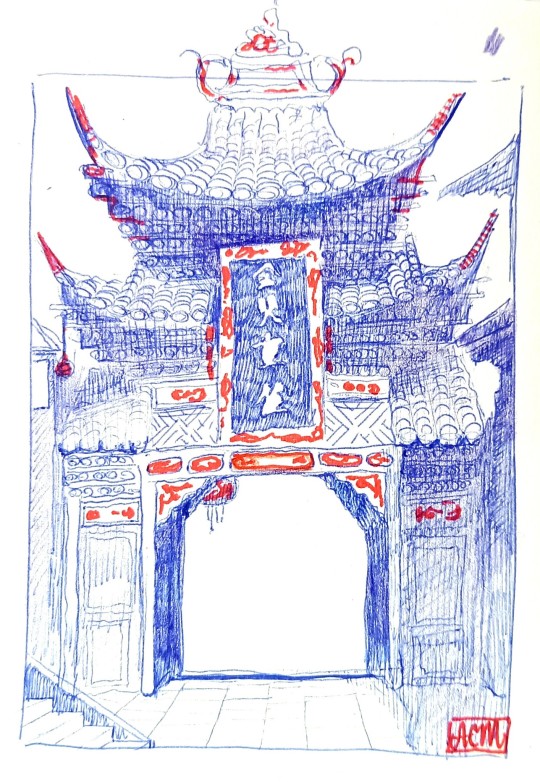
#mine#art#myart#artist on tumblr#traditional art#my art#illustration#artists on tumblr#bic pen#pen art#blue#asia#history#ancientmonuments#ancient asia#i used a ref on pinterest but couldn't find where this is...#architecture#gate#asian architecture#artwork#sketching#colored pencils#doodle#japan#japanese culture#travel#world#red#ink drawing
6 notes
·
View notes
Text

The remains of the intricately tattooed body of Apo Annu, a tribal leader from the Benguet province of the Philippines who died more than 500 years ago. Archaeologists believe people from this region earned their tattoos—typically geometric shapes and animals—in battle. Photograph By Gunther Deichmann
The Ancient History of Tattoos—Revealed By Inked-up Mummies
Humans have been getting ink for at least 5,200 years. Here are some of the most intriguing ancient tattoos, from cultic symbols to complex horse motifs.
— By Erin Blakemore | June 5, 2023
If you got a tattoo, what kind of ink would you choose and why? The answer might reflect everything from a spur-of-the-moment decision to a poignant tribute to a loved one. But you may not realize that tattoos have an ancient—and fascinating—history.
The word “tattoo” was imported into English thanks to Captain James Cook, who noted the practice, and Tahitian word “tatau” describing it, in Polynesia in the 18th century. But scholars agree that the practice far predates the word itself—and the skin of ancient mummies proves their point.
Who are these inked-up mummies, and what can they teach us about ancient cultures? Here’s a not-at-all exhaustive look at some of the most intriguing tattoos that archaeologists have found from the past and what they tell us about the ancient world.
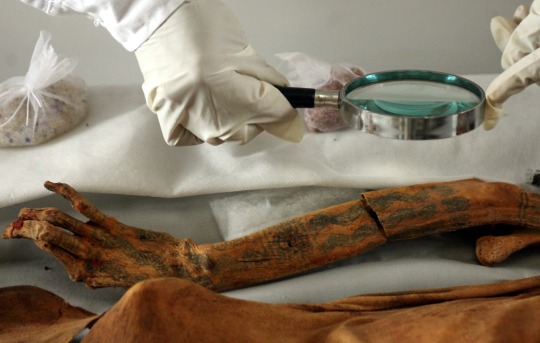
An archaeologist inspects the tattooed arm of a mummy, known as the Lady of Cao, from Peru's ancient Moche culture. This young woman— believed to be member of the Moche elite—died around A.D. 450. Her tattoos of spiders and snakes suggest she was spiritual. Photograph By STR New, Reuters/Redux
Tattoos in Ancient Western Europe
The earliest evidence of tattooing is inked into the body of Ötzi the Iceman. Europe’s most famous mummy, Ötzi (also known as “The Iceman”) was discovered by German hikers in the Alps in 1991. Ötzi lived in Tyrol, a mountainous region that borders modern-day Italy and Switzerland, about 5,200 years ago, and after he died his body, and its tattoos, were preserved by ice and the elements.
Archaeologists have since documented 61 line-like tattoos on his body thought to have been created by piercing the skin and applying charcoal dust. Some of them were on areas associated with pain in aging like the knees and ankles, leading archaeologists to theorize that they were created during some kind of pain treatment. But other geometric tattoos on Ötzi’s chest suggest that tattoos had some kind of ritual, ceremonial, or even religious use as far back as the Neolithic age.
The exact meaning may be debated for the next five millennia, though, since researchers concede that without more evidence, there’s no way to know why Ötzi, or other Neolithic people, got inked.
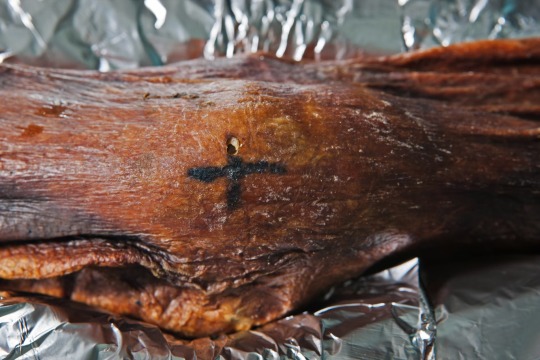
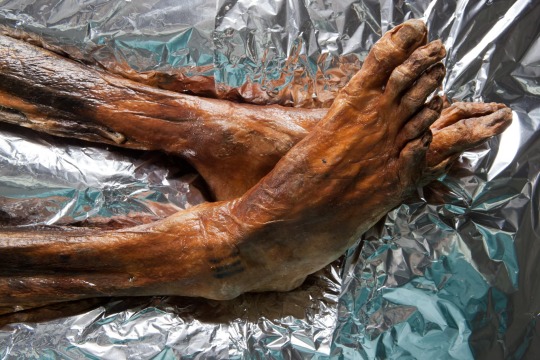
Top: The earliest evidence of tattooing can be found on the body of Ötzi the Iceman. One of those tattoos, found near his knee, is cross-shaped. Bottom: Ötzi also has a series of line-like tattoos on his body that archaeologists have theorized may have something to do with pain treatment or ritual use. Photographs By Robert Clark, National Geographic Image Collection
Tattoos in Ancient Egypt
The next earliest evidence of tattoos comes from mummies thought to have died between 3351 and 3017 B.C. in ancient Egypt. Discovered in 1900, the bodies were found to sport tattoos in 2018, when researchers re-examined them using infrared imaging and found that what looked like smudging on the skin was actually body art. Their ink is the earliest known evidence of tattoos depicting images—including a wild bull and a sheep on the male’s arm, and symbols resembling the letter “S” and possibly a staff on the female’s arm and shoulder.
The images, which mirror motifs found in other ancient Egyptian art, are the first evidence of tattooing in Africa. Though researchers can only speculate on what the tattoos meant to their bearers, they could have been status symbols or proof of the wearer’s skills such as bravery or knowledge of cult or ritual practices. The differences between the male and female mummies’ tattoos suggest some kind of gender or social system.
Other tattoos dating from later periods suggest that tattoos were eventually used as cultic symbols in ancient Egypt. In one case, archaeologists discovered more than 30 visible and diverse images, from lotus blossoms to the Eye of Horus, on the skin of a female mummy found in the Valley of the Kings. She is thought to have lived in the Ramesside period of 1292 to 1189 B.C., and researchers believe her tattoos show that she was a priestess or magician with a particular connection to the ancient sky goddess Hathor.
Tattoos in the Americas
Tattooing is thought to have been practiced across the Americas, from the Arctic circle to the south. One mummy from the Chinchorro culture in what is now Chile was once thought to sport the oldest known tattoos, a mustache-like set of black dots under his nose. That idea has since been debunked; more recent research revealed that the Chinchorro man died between 2563 and 1972 B.C.—and is therefore not older than Ötzi as previously believed. Either way, the reasons for his tattoo stump researchers since he is the only known mummy from his culture with one.
The “Toltec Mummy,” a woman thought to have lived around A.D. 250 in what is now Mexico, was discovered with complex tattoos on her forearm that reflect undulating geometric motifs common throughout the region. Though researchers can’t pinpoint the exact reason for the tattoos, they speculate they warded off sickness or were part of some kind of initiation rite. I
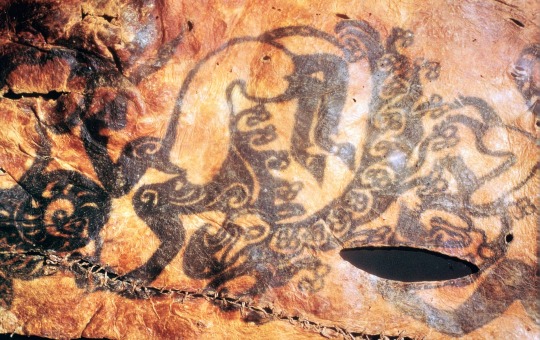
Beasts tattooed on the arm of a Scythian child whose body—which dates back to the 5th century B.C.—was found in the Altai region of Russia. Archaeologists believe this culture's tattoos reflect age and social status. Photograph By CM Doxon, Print Colector/Getty Images
Tattoos in Ancient Eastern Europe
Members of the Catacomb culture in Eastern Europe from around 2600 to 2400 B.C. also had tattoos. Their mummified remains, found near the Sea of Azov in what is now Russia, bore plant-dye tattoos representing snakes that researchers believe were part of “sympathetic magic” practices and social roles.
Animal tattoos have also been found on the bodies of members of the Pazyryk culture, which emerged during the Scythians’ domination of what is now Russia between the sixth and second centuries B.C. These Iron-Age nomads lived in the Altai Mountains and depended on horses to live, and even die—they were buried alongside their horses, as in the case of an ice-preserved woman discovered in 1993 alongside six bridled and saddled horses. The high-status woman, along with other buried Pazyryk people, was covered in tattoos of complex horse motifs.
Some researchers believe the tattoos reflected age and social status, meaning that as one gained both they also got more and more ink. Psychology and animal studies specialist Gala Argent posits that the tattoos signified a personal connection to individual horses, and that they provide important evidence about how humans and horses interacted when they were alive.
Tattoos in Ancient Asia
Despite modern-day tattoo stigma in China, a variety of ancient cultures across Asia embraced the practice.
In China’s Tarim Basin, for example, the discovery of mummified bodies dating from between 2100 and 800 B.C. shows the prevalence of tattoos across a variety of cultures from the area. Most of those tattoos are located on the mummies’ hands, but tattoo historian Svetlana Pankova notes that a few have face tattoos. She has called for more research on the Tarim tattoos, claiming that with a re-examination of these bodies, “it is likely that many new tattoo discoveries will be made.”

A Scythian mummy displayed at the Martin-Gropius-Bau exhibition hall in Berlin. Mummification preserved the striking tattoo visible across the man's right shoulder. Photograph By Axel Schmidt, DDP/AFP/Getty Images
Tattoos in Oceania
Despite the Tahitian origin of the word “tattoo,” archaeologists have found relatively little evidence of tattooing from ancient Polynesia—the tropics’ warm, wet weather doesn’t lend itself well to mummification. In 2019, researchers identified a set of tattoo tools made of human bone thought to date from the dawn of Polynesian culture in what is now Tonga around 2,700 years ago.
But scholars still aren't sure what kinds of motifs were preferred by ancient Polynesians or what the markings meant to Polynesians, speculating that they could have indicated belonging to a particular social group, rites of passage, or a desire to be protected from harm.
As French art historian Luc Renaut explains in an essay in Ancient Ink: The Archaeology of Tattooing, representations of “possibly tattooed” figures in ancient artworks offer a tantalizing view of even earlier tattooing practices. But “few survive close scrutiny,” and ancient artistic styles cannot reliably be interpreted as portraying real-life tattoos.
That, along with a dearth of mummy evidence older than Ötzi, suggests that the true history of tattooing may never be fully uncovered. In the meantime, though, there’s plenty of ink to look for—and more to learn about a truly ancient practice.
#Ancient History of Tatoos#Western Europe#Ancient Egypt 🇪🇬#The Americas 🇺🇸#Eastern Europe#Ancient Asia#Oceana
7 notes
·
View notes
Text

one of my old works
4 notes
·
View notes
Text

Petra - Jordan (by Anna Jewels (@earthpeek))
https://www.instagram.com/earthpeek/
#Petra#Jordan#Jordanien#Asia#Asien#Landmark#Old#Historic#Ancient#Sight#Sightseeing#Photography#Travelling#Traveling#Travel#Tourism#Holiday#Urlaub#Reisen#Vacation
2K notes
·
View notes
Text
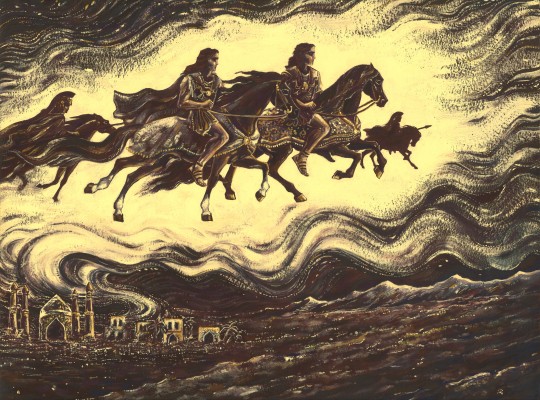
Spirits of ancient battles. Memories of Alexander the Great (2023/2024)
Gouache version of the work from 2017: https://www.tumblr.com/marysmirages/686070565494259712/spirits-of-ancient-battles-memories-of-alexander?source=share
#alexanderthegreat#hephaestion#hephaistion#alexander of macedon#marysmirages#asia#ancient greek mythology#painting#art#horse#rider#mirage#oasis#persia
404 notes
·
View notes
Text

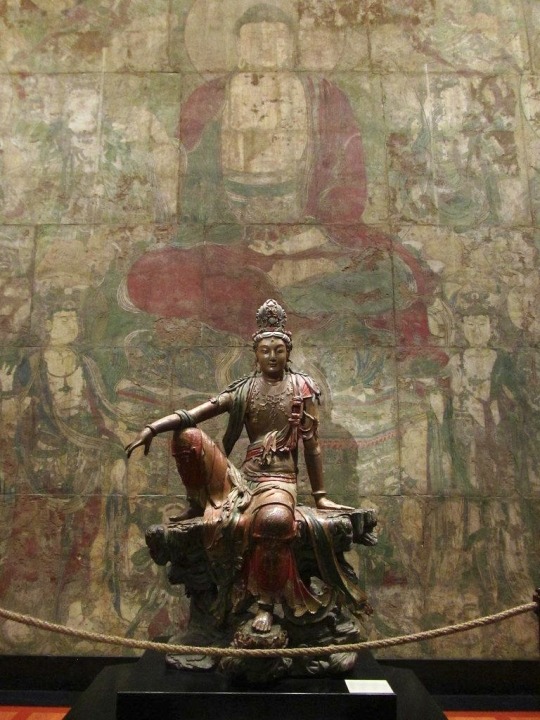
Guanyin of the Southern Sea
A wood statue of the Chinese-Buddhist deity Guanyin. Made during the Liao (916–1125) or Jin (1115–1234) dynasties.
It’s currently located in The Nelson-Atkins Museum of Art, Kansas City, Missouri.
#china#chinese culture#chinese history#east asia#Buddhism#Chinese Buddhism#zen buddhism#guanyin#museum#artifact#wood statues#statues#Buddhist deity#medieval china#ancient china
466 notes
·
View notes
Text

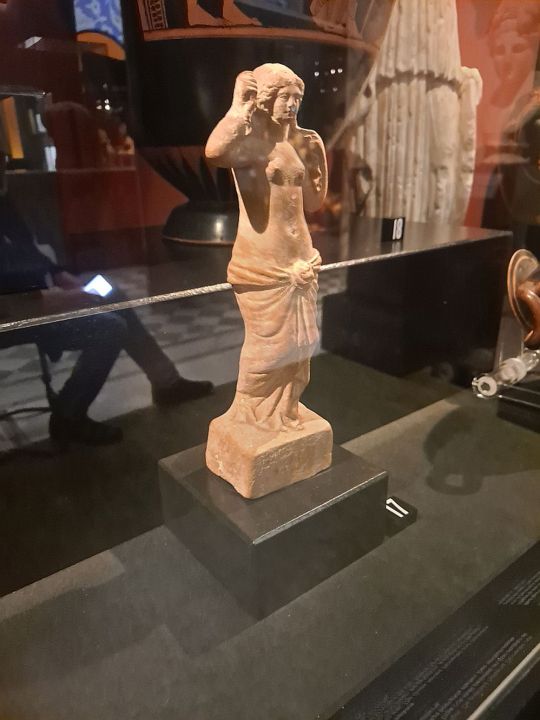

Aphrodite
* Asia Minor
* 300-100 BCE
* terracotta
* Medelhavsmuseet, Stockholm
Stockholm, November 2023
#Aphrodite#goddess#ancient#Greek#art#terracotta#statuette#2nd century BCE#3rd century BCE#Asia Minor#Medelhavsmuseet Stockhom#Swedish Museums#my photo
220 notes
·
View notes
Text

Ornamented pottery in the "Fire Flame" style, dating to the Middle Jomon period (ca. 2500-1500 BCE). Found at Sasayama, Niigata Prefecture, Japan; now in the Tokyo National Museum.
#art#art history#ancient art#prehistoric art#prehistory#Japan#Japanese art#East Asia#East Asian art#Jomon#Jomon period#pottery#ceramics#Tokyo National Museum
599 notes
·
View notes
Text

Alexander covering the body of Darius with his cloak
by Charles Meynier
#alexander the great#darius#art#charles meynier#antiquity#history#europe#european#asia#persia#persian#ancient greek#ancient greece#macedonian#macedonia#greek#greece#achaemenid empire#macedonian empire#king#persian empire
190 notes
·
View notes
Text

Seated deity. Indonesia, Central Java, 9th Century. Now located at Brooklyn Museum.
#ancient world#history#ancient history#archaeology#art history#world history#classics#southeast asia#asian history#asian art
289 notes
·
View notes
Text

The Sun and Moon Pagodas in Guilin, China (photo by Nathan Ackley)
Sun & Moon Twin Pagodas are one of the greatest attractions in Guilin, situated in Shanhu (Shan Lake).
The word sun and moon in Chinese character written together meant brightness. They are also known as Gold and Silver Pagodas because of their colors at night. They stand next to each other reflecting the beauty of each other.
Originally built in Guilin's moat during the Tang dynasty, these tiered towers were reconstructed in 2001 and now they are a tourist site combining culture, art, religion, and architecture, technology, and natural landscape.
The "Sun" Pagoda is constructed with copper; it has 9 floors and reaches a height of 41 metres. The "Moon" Pagoda's construction is made of marble; it has 7 floors and measuring 35 meters high. The two pagodas are connected via a tunnel at the bottom of the lake.
From the Moon Pagoda to the Sun Pagoda, there is a 10-meter glass tunnel that links the two under water. When walking through the tunnel, one can see the fish above the head and on both sides.
#sun and moon pagoda#china#chinese architecture#asian architecture#asia#chinese culture#asian culture#pagoda architecture#pagoda#buddhism#tang dynasty#photography#aesthetic#religion#asian religion#chinese religion#ancient china#ancient tradition#sun and moon
1K notes
·
View notes
Text
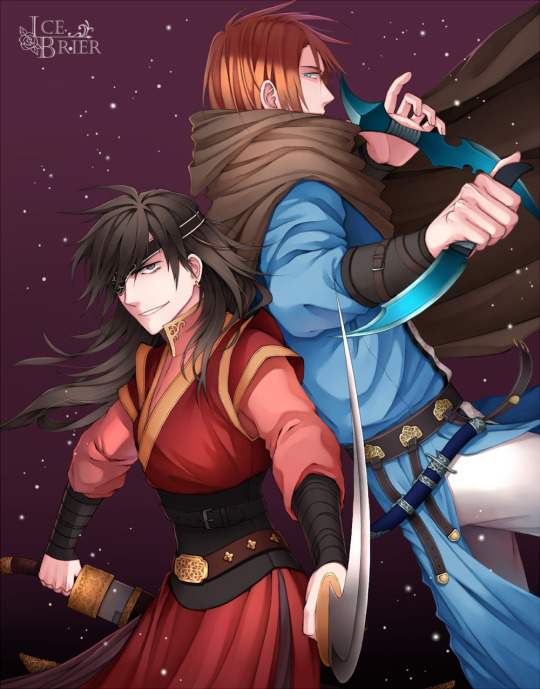
My OCs
1 note
·
View note
Text

P E R S E P O L I S
210 notes
·
View notes